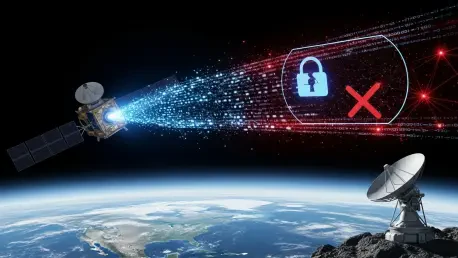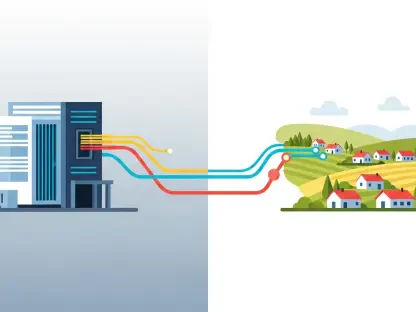Imagine a world where private phone calls, financial transactions, and even military communications are broadcast openly across the skies, accessible to anyone with a simple satellite dish costing less than a thousand dollars. This unsettling reality has come to light through recent research conducted by experts from UC San Diego and the University of Maryland, revealing a staggering vulnerability in satellite technology. A significant number of geostationary (GEO) satellites, which orbit far above Earth and cover vast swaths of the planet, transmit sensitive data without any form of encryption. This means that personal messages, critical infrastructure information, and commercial secrets are exposed to potential eavesdroppers, ranging from curious hobbyists to malicious actors. The scale of this security flaw is both alarming and far-reaching, affecting civilian, financial, and defense sectors alike. As reliance on satellite communications grows, the implications of this oversight demand urgent attention and action.
Unveiling a Hidden Vulnerability
The discovery of unencrypted satellite transmissions has sent shockwaves through the cybersecurity community, highlighting a blind spot in a technology that underpins much of modern life. GEO satellites, often used by major telecommunications companies and military operators, beam signals across approximately 40% of Earth’s surface, making their data accessible over vast regions. Researchers initially set out to evaluate the strength of encryption models on these systems, only to uncover that many lack any protective measures whatsoever. This absence of security transforms what should be private communications into public broadcasts, easily intercepted with minimal equipment. The types of data at risk are diverse, spanning personal conversations, banking details, and even surveillance feeds critical to national security. Such exposure creates a perfect storm for exploitation, where the potential for privacy breaches and data theft looms large over unsuspecting users and organizations worldwide.
This vulnerability is not a result of sophisticated hacking techniques but rather a fundamental oversight in design and implementation. Historically, satellite communications were developed at a time when the need for encryption was underestimated, much like the early days of the internet before secure protocols became standard. Unlike web browsers that have widely adopted Transport Layer Security (TLS) to safeguard data, many GEO satellite systems have remained stagnant, failing to evolve with modern threats. The assumption that these signals were too obscure or difficult to intercept has proven dangerously flawed, as affordable technology now enables virtually anyone to listen in. The consequences of this gap are profound, affecting not only individual privacy but also the integrity of global infrastructure. As awareness of this issue spreads, the likelihood of exploitation by cybercriminals or hostile entities increases, underscoring the urgency of addressing this long-standing flaw in satellite security practices.
Historical Oversights and Modern Risks
Delving deeper into the root causes, it becomes clear that the lack of encryption in GEO satellite communications stems from a historical complacency that has persisted for decades. When these systems were first deployed, the focus was on functionality and coverage rather than security, under the mistaken belief that their signals were inherently protected by their distance from Earth. This mirrors the early internet era, where data was transmitted in plain text because the risks of interception were not yet apparent. Over time, as cyber threats evolved, the internet adapted with robust protocols like TLS, evident in the widespread use of HTTPS. Satellites, however, have lagged behind, leaving a critical technology vulnerable to exploitation in an age where data breaches are commonplace. This outdated approach to security is a stark reminder of how legacy systems can become liabilities if not updated to meet contemporary challenges and evolving threat landscapes.
The modern risks associated with unencrypted satellite data are both immediate and severe, with potential impacts spanning personal and societal levels. Anyone with basic equipment can intercept transmissions that include sensitive information, such as financial logins or operational details of critical infrastructure. This accessibility opens the door to a range of malicious activities, from identity theft to espionage by state-sponsored actors. Although public instances of exploitation remain limited, researchers caution that this could change rapidly as knowledge of the vulnerability spreads. Foreign intelligence agencies may already be tapping into these unsecured streams, though concrete evidence is scarce. The potential for space-based cybercrime is a growing concern, as the ease of access to satellite signals could inspire a new wave of digital threats. This situation emphasizes the need for proactive measures to secure these communications before they become a widespread target for exploitation.
Pathways to Securing the Skies
Amid the concerning revelations about satellite vulnerabilities, there is a silver lining in the form of feasible solutions that can mitigate these risks. One of the most straightforward fixes is the adoption of TLS protocols, a security measure already proven effective in internet communications and implemented by newer systems like SpaceX’s Starlink satellites in low-Earth orbit. Following the release of a recent white paper by researchers, several major companies, including T-Mobile and Walmart, have taken swift action to encrypt their satellite systems, likely through software updates rather than costly hardware overhauls. This rapid response demonstrates that securing GEO satellite data is not only possible but also achievable in a relatively short timeframe. Such developments offer hope that the industry can address this critical flaw without requiring a complete redesign of existing infrastructure.
Looking ahead, the focus must shift to establishing encryption as a standard across all satellite communications, ensuring that no data is left unprotected. The broader implications of this issue serve as a wake-up call for stakeholders to prioritize cybersecurity in space-based technologies. Governments, telecommunications providers, and military operators must collaborate to implement robust security protocols and regularly update legacy systems to counter emerging threats. The success of quick fixes by some entities highlights the potential for widespread change if urgency is maintained. Beyond technical solutions, raising awareness about the risks of unencrypted data can drive demand for secure systems and hold companies accountable for protecting user information. Reflecting on past oversights, it becomes evident that the path forward involves learning from internet security advancements and applying those lessons to the skies, safeguarding a vital component of global connectivity for future generations.









